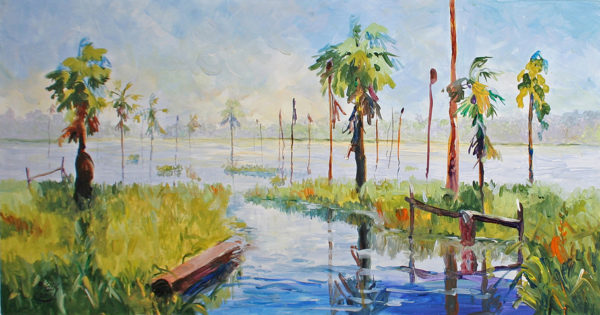This month, artists Stanley Greaves AA and Akima McPherson turn their attention to Merlene Ellis’s acrylic painting A Slice of Itiribisi, which was completed in 2006. A Slice of Itiribisi, part of the National Collection, will be available for viewing at the National Gallery of Art, Castellani House during the month of October.
Akima McPherson: Guyanese artists collectively reflect a love and fascination for the Guyana landscape; our landscape is a frequent reference point for painters in particular. Merlene Ellis is no different. Her treatment of the landscape is typically naturalistic – showing the land as her eye sees it. In A Slice of Itiribisi she shows us a snippet of land and of lifestyle. Her colours are bright and vibrant and clean. Her application of paint is spontaneous and has an impressionistic quality. And she exploits the acrylic medium’s ability to be mixed with water and be applied in thin layers.

Stanley Greaves: Ellis’ A Slice of Itiribisi from the first time I saw it struck me as being one of the most lyrical, song-like landscape paintings in the National Collection. She was able also to capture a quality of light that is quite striking. This is a difficult thing for landscape painters who mostly deal with local colour – the natural colour of things lacking the dynamic quality of reflected light. Ellis is a real painter in the same sense as Cletus Henriques and Bernadette Persaud, in making us aware not only of what is being portrayed but also to the lively quality of paint itself. She certainly captures the liquid quality of the coastal swamp landscape in the free manner of paint application which makes it a kind of drawing-in-colour as well.
AM: I do like your choice of the word lyrical. The light within the composition is bright but not harsh and that along with the space conveyed within the image invites exploration. There is clear indication of foreground, middle ground and background from the lower edge of the painting to the upper portion. The composition is a great demonstration of atmospheric perspective. Within the foreground a log, trees and fabric draped over a simple construction are presented with greater clarity than the trees furthest away – the trees on the opposite bank.
SG: The atmospherics do present a sense of space, using accepted artistic practice. Light tones for effects of distance. In fact, because of the strength of tropical light, the trees in the background would have been clearly seen. The need to be poetic probably led Ellis to dispense with what the eye could see clearly. There is a definite joy in paint application allowing the observer to appreciate the substance of paint and imagery all combined as a treat to the eye. A Slice of Itiribisi in its appeal to the visual sense allows the viewer to enter the landscape in a way that can be related to listening to music. I am reminded to some extent of some of the Impressionistic style landscapes of Hubert Moshett in his prime.




